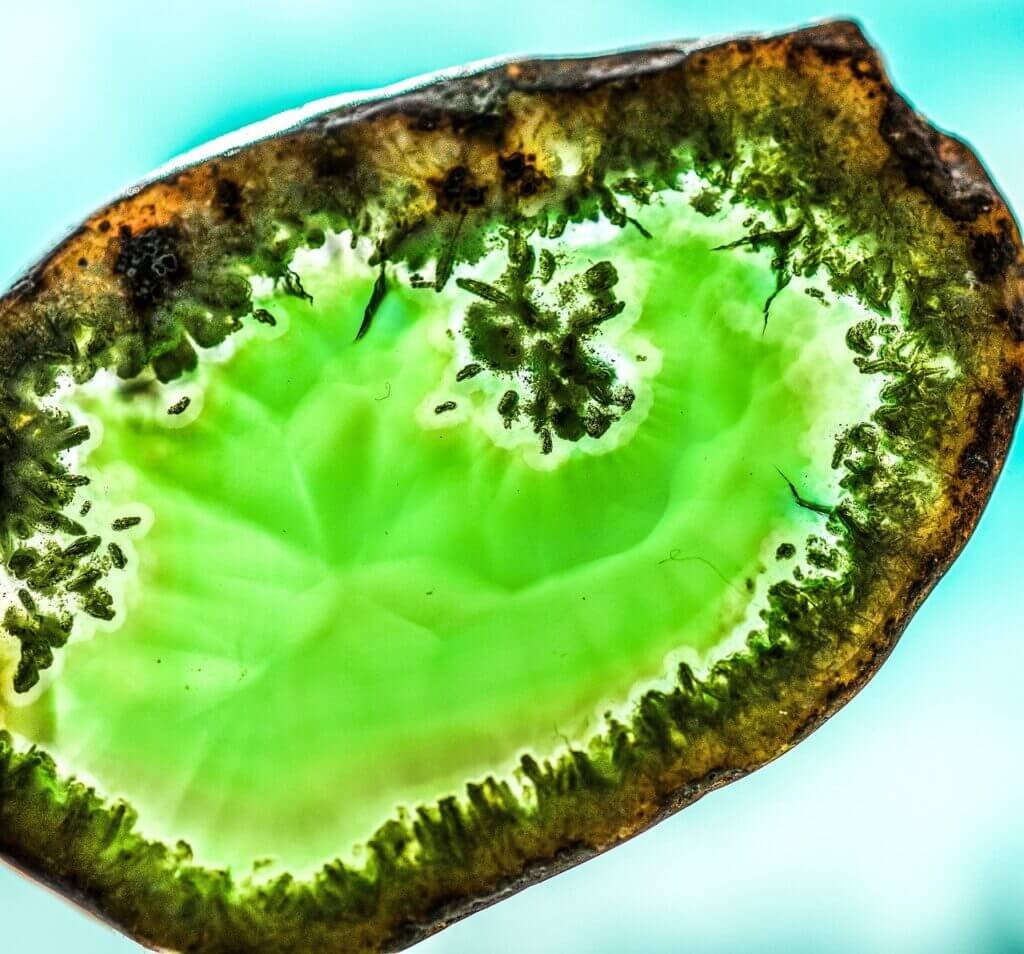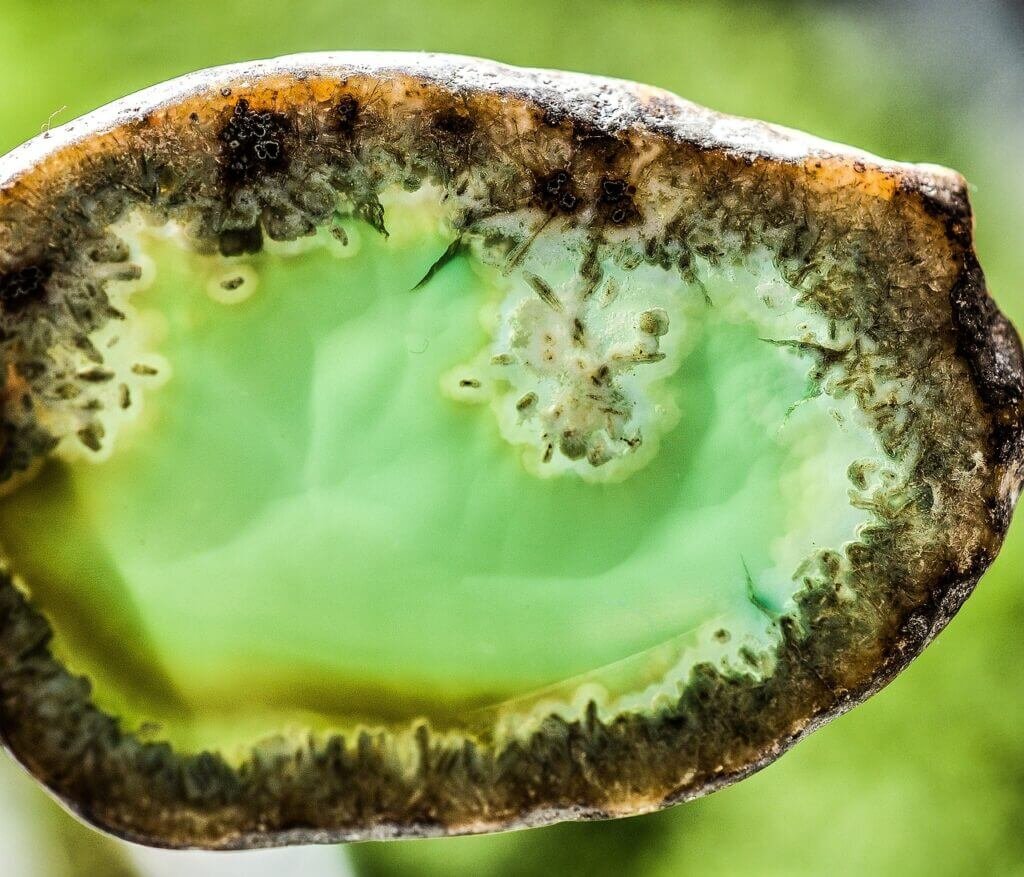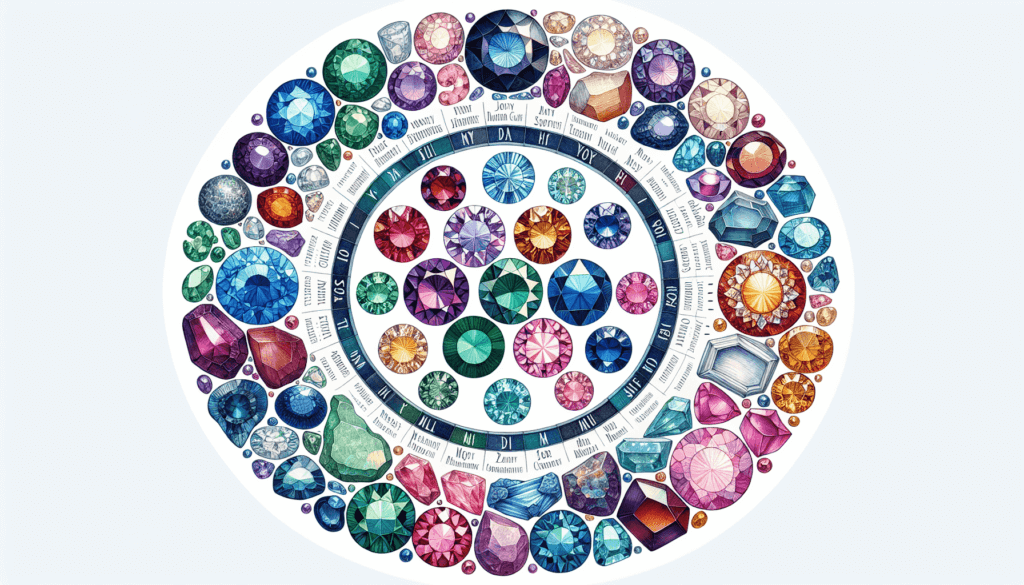Have you ever wondered about the significance of the semi-precious stone associated with your birth month? If so, you’ll find this article intriguing as it explores each birth month’s semi-precious stone, their origins, and the meaning behind them. From garnet for January to turquoise for December, you will discover a riveting world of colour, sparkle and history. Be ready to embark on a journey exploring the beauty and mysticism encompassed in each of these magnificent semi-precious stones.

January’s Birthstone: Garnet
January’s birthstone, the Garnet, is a gem that exudes warmth and light. Its name is derived from the Latin “granatum” which means seed, as it resembles a seed of a pomegranate.
Historical significance of Garnet
Garnets are rich in history and have been used by different cultures since the Bronze Age. They were especially prevalent in Roman culture, often used in signet rings as a symbol of power and prestige. In the Middle Ages, they were often associated with religious figures and thought to give protection from evil.
The symbolism of Garnet
The Garnet symbolizes faith, truth, and consistency, which makes it a perfect gift for friends and lovers. It is often associated with qualities such as love, friendship, light and vitality.
Types of Garnet
There are many distinct types of Garnets, each possessing its own unique color and qualities. The most common types include almandine, pyrope, spessartine, andradite, grossular, and uvarovite.
The metaphysical properties of Garnet
Garnet is believed to stimulate passion, creativity, and increase physical energy. It’s also thought to bring courage and hope to the wearer. It is often used in meditation as a tool for grounding and centering the user.
February’s Birthstone: Amethyst
The Amethyst, February’s birthstone, is known for its stunning violet color and was once considered as valuable as a diamond.
The mythology surrounding Amethyst
According to Greek mythology, Amethyst was a crystalline quartz dyed purple by the tears of Dionysus, the god of wine and festivities. It was believed the gemstone could prevent drunkenness and infuse the wearer with a sober and serious mind.
Different hues of Amethyst
Amethyst comes in a range of hues from deep purple to a lighter lilac, depending on where it’s found. The depth of color is determined by the amount of iron contained in the crystal structure.
The metaphysical attributes of Amethyst
Amethyst is said to possess calming properties that can reduce stress and anxiety. It is also believed to enhance spiritual awareness and promote emotional balance.
Amethyst in gemmology and jewelry
In gemmology, Amethyst is considered a semi-precious gem and is often used in jewelry due to its versatility and beautiful range of colors.

March’s Birthstone: Aquamarine
Aquamarine, the birthstone for March, is a stunning blue crystal, loved for its calming and soothing color reminiscent of the sea.
Aquamarine in various cultures
In different cultures, Aquamarine has been seen as a symbol of youth, hope, and health. It has been used in meditation and religious ceremonies to bring about peace and serenity.
Sources of Aquamarine
Aquamarine is predominantly found in Brazil, Madagascar, Namibia and Pakistan. The darker, deeper blues of Aquamarine, which are rare, often come from the deepest mines of Brazil.
Metaphysical and healing properties of Aquamarine
Aquamarine is said to bring mental clarity and emotional relief to the wearer. It’s also believed to aid in communication and ensure a smooth flow of energizing and balancing energies.
Kinds of gems related to Aquamarine
Beryl, emerald and morganite are all related to Aquamarine. Each of these gems share similar attributes, but come in a variety of stunning shades.
April’s Birthstone: Diamond
Diamonds, April’s birthstone, are renowned for their unbeatable hardness and characteristic sparkle. They are the ultimate symbol of eternal love and strength.
Diamond: A Symbol of invincibility
Diamonds are often associated with invincibility due to their impressive strength. This has made them a popular choice for engagement rings symbolising a love that will never break.
Various facets of Diamond
A diamond’s facets are the numerous flat planes cut onto the surface of the gem. Each diamond can have up to 57 or 58 facets, depending on whether a culet is present.
Role of Diamond in gemology
Diamonds play a large role in gemology due to their unique physical properties. Gemologists use tools and techniques specifically designed to identify and grade diamonds based on these exclusive attributes.
Healing and metaphysical properties of Diamond
Diamonds are said to carry high frequency energy that stimulates and opens all of the chakras, especially the crown and etheric chakras. They are believed to inspire creativity, imagination, inventiveness and ingenuity.

May’s Birthstone: Emerald
The Emerald is May’s birthstone. Known for its lush, green color, this gem has enchanted humanity for thousands of years.
Historical connotations of Emerald
The earliest known emerald mines were in Egypt, dating back to 330 BC. These precious stones were highly valued by pharaohs and were often buried with them as a symbol of eternal youth.
The color spectrum of Emerald
The color of an Emerald can range from light to dark green, based on the amount and type of inclusions present in the stone. The most valuable emeralds are a deep green-blue.
Metaphysical beliefs about Emerald
The Emerald is believed to bring abundance, growth, peace, and balance. It is also thought to help in creating harmony in all areas of life.
Role of Emerald in jewelry and gemology
Loved for its vibrant green shade, the Emerald has been used in jewelry for centuries. In gemology, the Emerald belongs to the illustrious beryl family, which also includes aquamarine.
June’s Birthstone: Pearl
June’s birthstone, the Pearl, is unique among gemstones because it doesn’t arise from the depths of the earth but from the sea.
Origin and formation of pearls
Pearls are formed when an irritant, such as a bit of sand, gets inside an oyster’s shell. As a defense mechanism, the oyster secretes a smooth, crystalline substance called nacre around the irritant.
Cultural importance of pearls
Pearls have been highly valued as gemstones since ancient times. They symbolize purity, nobility and beauty, and have often been associated with love and marriage.
Mystical and therapeutic properties of pearls
Pearls are known for their calming effects and are said to balance one’s karma. Additionally, pearls are thought to stimulate the mind and increase clarity and wisdom.
Types and shapes of pearls
There are several types of pearls, including freshwater, saltwater, akoya, Tahitian and south sea pearls. Their shapes also vary, but the most highly prized are perfectly round pearls.

July’s Birthstone: Ruby
The Ruby, July’s birthstone, is considered the king of precious gems. Its deep red color symbolizes love and passion.
Ruby in different historical contexts
Rubies have been treasured for thousands of years, serving as a representation of power and status in many cultures. In Asian countries, rubies were laid beneath the foundation of buildings to secure good fortune.
Colors and types of Ruby
While the most sought-after color is a blood-red with a hint of blue, rubies come in various shades of red. The three main types of ruby are Burmese, Thai, and African.
Metaphysical attributes of Ruby
The Ruby is said to ignite the passion within. It is a stone of courage, power, and enthusiasm, inspiring a zest for life.
The use of Ruby in gemology and jewelry
Due to the Ruby’s hardness, it is highly respected in the realm of gemology and makes an excellent choice for jewelry that is worn every day, such as rings and bracelets.
August’s Birthstone: Peridot
Peridot, August’s birthstone, is one of the few gemstones that occur in only one color, a unique shade of green.
Origins and locations of Peridot
Peridots are found in a variety of exotic locations, including Norway, Brazil, China, Hawaii, Australia, and even in some meteorites that have fallen to earth.
Symbolism and cultural importance of Peridot
Peridot has been adored for centuries, believed to possess magical powers and healing properties. It was known as the stone of the sun, promising good luck, fortune, and peace.
The healing and metaphysical properties of Peridot
Peridot is believed to reduce stress, stimulate the mind, and elevate moods. It also is said to be beneficial in healing matters of the heart, puffiness, and discomfort.
Different facades of Peridot
Peridot boasts a vibrant, bright green color with a subtle hint of gold. The intensity and tint of the green can vary depending on how much iron is contained in the crystal structure.

September’s Birthstone: Sapphire
The Sapphire, September’s birthstone, is a precious gem of wisdom and royalty, and is associated with sacred things.
History and cultural impact of Sapphire
Throughout history, sapphires have decorated the robes of royalty and clerics. They’ve served as symbols of nobility, truth, sincerity, and faithfulness.
Range of colors in Sapphire
Interestingly, sapphires come in a range of colors and not just blue. They can be colorless, and shades of gray, black, or brown and even show pink, orange, yellow, green, and violet.
Metaphysical importance of Sapphire
Sapphires are believed to bring wisdom, virtue, good fortune and divine favor. They are also associated with dispelling negative thoughts and bringing peace and joy to the wearer.
Sapphire in gemology and jewelry making
In gemology, the Sapphire is second only to the diamond in hardness, making it an excellent choice for jewelry. The most valuable sapphires are from Myanmar (Burma), Kashmir and Sri Lanka.
December’s Birthstone: Turquoise
Known for its distinct color, Turquoise is December’s birthstone. The blue to green mineral is one of the oldest stones known to man.
Origins and types of Turquoise
Most of the world’s turquoise rough is currently produced in the southwestern United States. Iran has been an important source of high quality turquoise for thousands of years. There is also turquoise in Mexico, China, Chile, Egypt, and Kazakhstan.
Symbolism and cultural value of Turquoise
Turquoise has been used for amulets for protection, adorned the ceremonial dress of chiefs, and was used by Native Americans to ensure a bountiful hunting trip.
Metaphysical and healing properties of Turquoise
Turquoise carries great wisdom of basic truth. It is a healer of the spirit, providing a soothing energy and bringing peace of mind.
Turquoise in jewelry design and gemology
Last but not least, turquoise is a stylish choice in the world of jewelry, most often used in rings, earrings, necklaces, and brooches. In gemology, Turquoise is appreciated for its pure and uplifting color, which never fails to capture attention.



